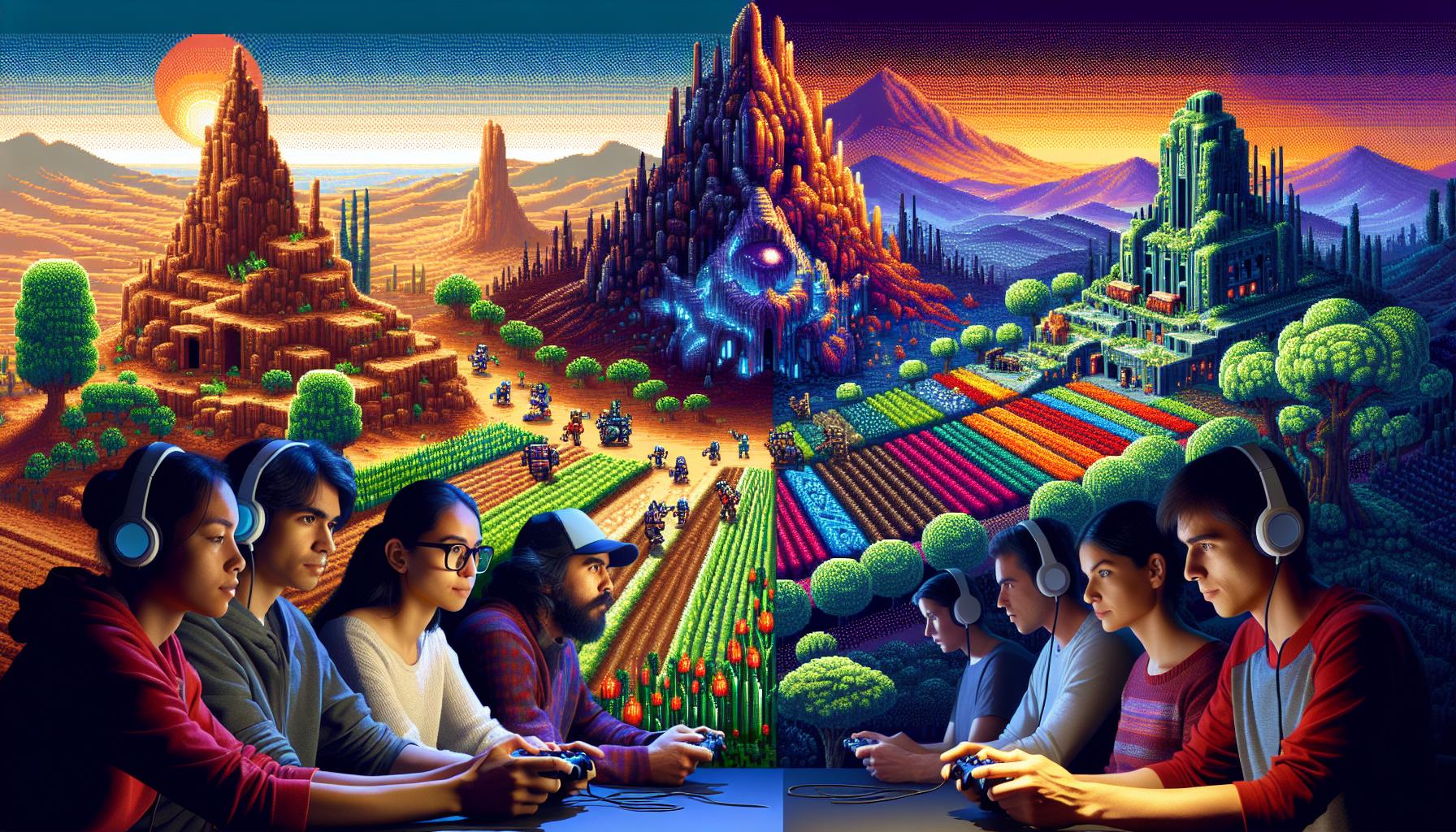Indie games have taken the gaming world by storm, proving that creativity and passion can rival big-budget titles. With unique storytelling and innovative gameplay, these games often resonate on a deeper level, capturing the hearts of players everywhere. From pixelated adventures to immersive narratives, indie games showcase the talents of small teams and solo developers who dare to think outside the box.
I’ve always been fascinated by how these games can create such rich experiences with limited resources. In this article, I’ll explore some of the most famous indie games that have left a lasting impact on the industry and players alike. Whether you’re a seasoned gamer or just curious about the indie scene, there’s something here for everyone.
Key Takeaways
- Creative Innovations: Indie games exemplify creativity, often introducing unique storytelling and gameplay mechanics that challenge traditional gaming norms.
- Emotional Connection: Titles like Journey and Celeste emphasize emotional narratives, allowing players to forge deeper connections with the game world and its characters.
- Distinct Art Styles: Many indie games feature memorable, vibrant art styles, such as the hand-drawn visuals in Hollow Knight, setting them apart from mainstream titles.
- Genre Diversification: Indie developers are expanding gaming genres, tackling significant themes like mental health and life-death cycles, as seen in Celeste and Hades.
- Community and Collaboration: The indie gaming scene fosters collaboration among developers, promoting innovation and resource sharing, which enhances the gaming landscape.
- Influence on the Industry: The success of indie games encourages larger companies to rethink their strategies, demonstrating that engaging gameplay can succeed without massive budgets.
Overview Of Famous Indie Games
Indie games have carved a niche in the gaming landscape, showcasing creativity and unique experiences. Their distinctive storytelling and innovative gameplay often lead to intense connections with players. Here’s a look at some of the most notable indie games that have left a mark on the industry.
- Journey: Released in 2012 by Thatgamecompany, Journey invites players to explore a vast desert landscape. The game emphasizes emotional storytelling through stunning visuals and an original soundtrack, allowing players to connect with each other without dialogue.
- Hollow Knight: Developed by Team Cherry, Hollow Knight combines large-scale exploration and intense combat. Its hand-drawn art style and atmospheric world-building resonate strongly with the Metroidvania genre, encouraging players to uncover hidden secrets.
- Celeste: Celeste by Maddy Makes Games highlights the struggles of mental health through a platforming narrative. The game’s mechanics offer a challenging experience while promoting themes of perseverance and triumph.
- Stardew Valley: Created by Eric Barone, Stardew Valley revolutionizes farming simulation games. Players manage a farm, build relationships, and explore caves, providing a wholesome escape from daily life’s stressors.
- Undertale: Developed by Toby Fox, Undertale subverts typical RPG mechanics. Its unique combat system allows players to choose non-violent options, leading to a variety of outcomes based on their choices, showcasing a comedic yet deep narrative.
- The Witness: Jonathan Blow’s The Witness presents players with a beautiful island filled with puzzles. The game emphasizes exploration and logic, rewarding players for their curiosity and analytical thinking.
- Hades: Supergiant Games’ Hades merges roguelike and RPG elements, allowing players to escape the Underworld. Its engaging story, dynamic character interactions, and addictive gameplay mechanics have garnered critical acclaim and numerous awards.
These indie games exemplify the potential of small teams to make a significant impact on the gaming world. Each title offers a distinct experience, reflecting the passion and creativity behind indie game development.
Key Features Of Indie Games

Indie games are recognized for their distinct qualities that set them apart from mainstream titles. Their creativity and innovation often capture players’ attention in unique ways.
Unique Art Styles
Indie games frequently showcase distinctive art styles, distinguishing them from big-budget productions. Many indie developers use vibrant pixel art, hand-drawn graphics, or minimalist designs to create memorable visuals. For instance, “Journey” features stunning landscapes with a painterly aesthetic, while “Cuphead” employs a 1930s cartoon style, enhancing its nostalgic appeal. These artistic choices compliment the narratives and gameplay, allowing indie games to express themes and emotions effectively.
Innovative Gameplay Mechanics
Indie games often experiment with gameplay mechanics that challenge traditional gaming norms. Developers prioritize creativity, offering fresh perspectives in gameplay design. “Undertale” subverts RPG conventions, letting players choose between combat and negotiation. “Braid” introduces time manipulation as a core mechanic, altering the way puzzles interact with the game world. This focus on innovation engages players and encourages exploration, making each indie game a unique experience that often differs significantly from mainstream offerings.
Notable Indie Games To Consider

Many indie games offer unique experiences that stand out in the gaming landscape. Here are three notable titles worth exploring.
Game 1: Hollow Knight
Hollow Knight features a beautifully crafted, hand-drawn world filled with intricate designs and challenging gameplay. Players navigate the vast kingdom of Hallownest, battling fierce enemies and uncovering its dark secrets. The game’s fluid combat system and rich lore engage players deeply, making each exploration session rewarding. With an expansive map and numerous upgrades, Hollow Knight invites players to discover every hidden corner, enhancing replayability.
Game 2: Stardew Valley
Stardew Valley revolutionizes the farming simulation genre with its charming pixel art and relaxing gameplay. Players inherit a dusty farm and transform it into a thriving agricultural haven. The game incorporates various activities like fishing, mining, and building relationships with townsfolk, creating a rich, immersive experience. Its open-ended nature allows players to shape their journeys, offering long-term playability and a calming escape from the chaos of daily life.
Game 3: Celeste
Celeste tackles significant themes such as mental health through its challenging platforming mechanics. Players control Madeline as she climbs the titular mountain, facing both physical and emotional obstacles. The tight controls and well-designed levels provide satisfying gameplay, encouraging players to master each challenge. Celeste’s narrative intertwines with its gameplay, delivering a powerful message about perseverance and self-acceptance in an engaging manner.
The Impact Of Indie Games On The Gaming Industry

Indie games significantly influence the gaming industry by introducing fresh perspectives and innovative ideas. Their ability to challenge conventional gaming norms often leads to groundbreaking gameplay experiences.
Indie developers prioritize creativity over financial constraints, resulting in unique narratives that resonate with players. For example, “Journey” moves beyond traditional gaming by immersing players in emotional storytelling through exploration. This approach encourages deeper connections between the player and the game’s world.
The success of indie titles prompts larger companies to rethink their strategies. Games like “Stardew Valley” demonstrate that simpler mechanics can create highly engaging experiences. Its popularity pushed other developers to explore similar gameplay styles, focusing on player engagement rather than graphical fidelity.
Furthermore, indie games lead to diversification in gaming genres. Titles such as “Celeste” and “Hades” bring themes like mental health and life-death cycles to the forefront, expanding the subjects that games can explore. This shift enriches the gaming landscape and attracts a broader audience.
Collaboration and community also thrive within the indie scene. Developers often share resources and collaborate on projects, fostering innovation. Platforms like Steam and itch.io provide vital support, allowing indie developers to showcase their work and connect with potential players.
The impact of indie games on gaming culture cannot be understated. They encourage experimentation and open dialogue among developers, players, and critics. As players demand more authentic and diverse experiences, indie games continue to shape the future of the industry. Their ongoing success ensures that independent voices remain vital, advancing creativity and originality in gaming.
Conclusion
The world of indie games continues to inspire me with its creativity and passion. These titles not only challenge the status quo but also invite players to experience unique narratives and innovative gameplay. I find it fascinating how small teams can craft such memorable experiences that resonate deeply with us.
As I explore more indie games, I’m excited to see how they push boundaries and redefine what gaming can be. The impact of these games on the industry is undeniable, driving larger companies to innovate and rethink their approaches. Indie games are more than just alternatives; they’re a vital part of gaming culture that encourages diversity and creativity.





